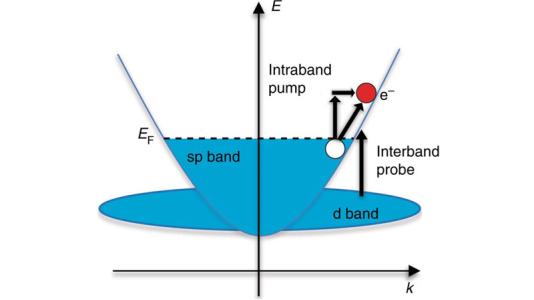
Scientific achievement
We obtained the distribution and dynamics of hot carriers (electrons) in a thin film by relating changes in the film’s reflectivity during pulsed laser experiments to known electronic information.
Significance and impact
This study provides a more direct measure of the evolution of hot carrier populations in a metal system —enhancing our fundamental understanding of the non-equilibrium dynamics of electrons.
Research details
- A tunable pulsed laser measured reflectivity of a 30 nm-thin gold film on top of a glass substrate as a function of time and probe frequencies; data were then inverted to obtain the underlying hot carrier distribution.
- Ultrafast transient absorption spectroscopy was performed at the Center for Nanoscale Materials.
DOI: https://doi.org/10.1038/s41467-018-04289-3
About Argonne’s Center for Nanoscale Materials
The Center for Nanoscale Materials is one of the five DOE Nanoscale Science Research Centers, premier national user facilities for interdisciplinary research at the nanoscale supported by the DOE Office of Science. Together the NSRCs comprise a suite of complementary facilities that provide researchers with state-of-the-art capabilities to fabricate, process, characterize and model nanoscale materials, and constitute the largest infrastructure investment of the National Nanotechnology Initiative. The NSRCs are located at DOE’s Argonne, Brookhaven, Lawrence Berkeley, Oak Ridge, Sandia and Los Alamos National Laboratories. For more information about the DOE NSRCs, please visit https://science.osti.gov/User-Facilities/User-Facilities-at-a-Glance.
Argonne National Laboratory seeks solutions to pressing national problems in science and technology. The nation’s first national laboratory, Argonne conducts leading-edge basic and applied scientific research in virtually every scientific discipline. Argonne researchers work closely with researchers from hundreds of companies, universities, and federal, state and municipal agencies to help them solve their specific problems, advance America’s scientific leadership and prepare the nation for a better future. With employees from more than 60 nations, Argonne is managed by UChicago Argonne, LLC for the U.S. Department of Energy’s Office of Science.
The U.S. Department of Energy’s Office of Science is the single largest supporter of basic research in the physical sciences in the United States and is working to address some of the most pressing challenges of our time. For more information, visit https://energy.gov/science.